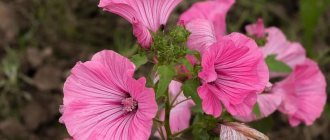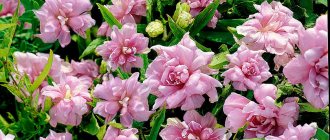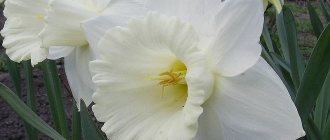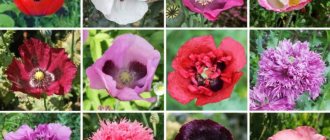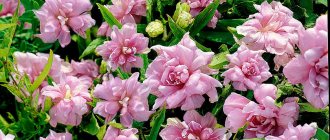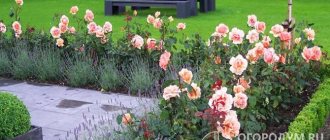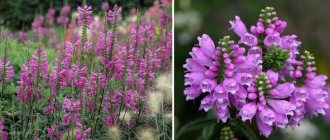Any gardener wants to make his flowerbed amazing and beautiful. To make a flower garden unique, there are a large number of flowers. I consider lavatera to be one of the most worthy of attention. Firstly, this plant blooms for a long time and beautifully, and secondly, it is very unpretentious in care. Lavatera seeds have good germination. Therefore, they can be planted directly into the ground, but in order for the plant to grow faster and bloom faster, to quickly show all its beauty, the seedling method of propagation is more preferable. But first things first.
Lavatera: description
Lavatera flower is popularly called khatma. It belongs to the malvaceae family and is similar in appearance to the hollyhock rose, especially the perennial lavatera. Shrub species, herbaceous crops, and even trees can be found in this genus. The genus is considered relatively small and includes about 25 species.
Rosa lavatera is often found in East Asia; it can be found naturally in Australia and the Mediterranean. The culture is named after the Lavater brothers from Switzerland. They were naturalists, naturalists and doctors. They loved all sorts of unusual plants. And in the 17th century this flower was planted in the garden. But annual and perennial lavatera gained popularity only a few centuries ago. Now this plant can be found in every garden.
Lavatera gardena has been studied by breeders for a long time. And thanks to their work, it was possible to develop many varieties of this extraordinary plant. The height of these plants ranges from 0.5 to 1.5 m. They have a well-developed root system. The stem of the bush is powerful and strong, as are the branches extending from it. The crown is spreading and during the flowering period it is completely strewn with flowers. The leaves of most species are arranged alternately, their blades are lobed and covered with hairs.
The diameter of the largest flowers is 10 cm, the color is the most varied: white, purple, yellow, pink and crimson. Flowers grow from the axils of the bract one or several at a time. Together they form racemose or spike-shaped inflorescences.
The first lavatera flowers can be seen in June, and flowering continues until mid-autumn. That is, this plant will decorate the garden all season. Khatma is ideal for those who have little time, because even without care it will bloom all summer. The plant tolerates periods of drought well, tolerates drafts and strong winds, is very undemanding to the soil, and cut flowers can last in a vase for about a week.
After flowering, the flower forms seed pods, the seeds of which can be sown without fear the following year.
End of flowering, collection of seeds
After flowering ends, round green boxes can be seen in place of wilted inflorescences. To collect seeds, you must wait until they are completely ripe. If the goal is to exclude self-seeding, you need to cut them off immediately after flowering. A sign of seed maturity is the brown color of the fruit capsule; the seeds easily fall out of it. Preparing them for future use requires good drying.
The germination of collected lavatera seeds lasts up to 5 years.
Lavatera: reproduction
Khatma can be propagated either by seed or vegetatively by dividing the bush. The most commonly used is seed. In regions with a harsh climate, it is recommended to first grow seedlings, and when the threat of frost has passed, lavatera is planted in the ground. In warm regions, plant seeds can be planted directly in open ground.
The vegetative propagation method is most suitable for perennial lavatera. In spring or autumn, divide the mother bush and transplant parts of the plant to the chosen location. Khatma tolerates this procedure well and easily settles into her new place.
When to plant depending on the region?
The timing of planting lavatera seedlings is directly related to the climate of the area and the weather of the current year.
In Moscow and Moscow region
In Central Russia, Lavatera is sown for growing seedlings in the first week of March. In case of a long winter or cold spring, it is postponed to the middle of the month.
In the middle zone
In March they are also sown in the regions of the Central zone. In warm early spring, this period shifts to the end of the last winter month - February.
In the Urals
The climate of the Urals is harsher than in the center of the country. Therefore, they sow in the middle or last week of March. And sometimes in the first week of April.
In Siberia
Siberian gardeners begin sowing at the very end of March. During a long winter - in April.
In the Leningrad region
The third and fourth weeks of March are the time for sowing Lavatera in the Leningrad region. In cold spring, the date shifts to the first ten days of April.
Lavatera: planting seeds in the ground
As mentioned above, in warm regions the plant can be planted directly into the ground. When to plant lavatera seeds ? It is advisable to carry out this procedure in the third ten days of April or early May. Before planting lavaters in open ground, the soil is first dug up and added to 1 sq.m. one bucket of humus or compost, you can add 2 tbsp to organic matter. l. nitrophoska.
After digging the soil and applying fertilizers, the soil is leveled and furrows 1 cm deep are made in the prepared area. The furrows are shed with warm water and dry lavatera seeds are sown in them, preferably the distance between the seeds is 10-15 cm. The furrows are filled with a mixture that should contain 50% from humus and 50% from garden soil. The crops are covered with film.
Usually seedlings sprout within a week. When the plants grow 5 cm in height, the cover is removed, the crops are thinned out, the soil around the seedlings is loosened, as if slightly hilling up the seedlings. If no fertilizers were applied when preparing the soil, then after removing the film, the young plants need to be fed. During this period, complex mineral fertilizer should be applied.
Landscape design
An interesting visual effect is created by the combination with lavender and iberis. The neighborhood with pansies, amaranth, lily, and petunia looks beautiful. A decorated flower bed on a green lawn looks no less impressive: it is pleasantly simple and nothing superfluous. But the proximity to crocosmia will unexpectedly surprise and attract attention.
Lavatera is suitable for natural, “wild” gardens. In home parks, where a large area is devoted to lawn, bushes are planted in groups in the form of lines or entire garden groups and ridges.
Flowers are often grown in pots and placed on balconies and terraces. It is recommended to choose varieties whose height does not exceed 100 cm.
Lavatera: planting seeds for seedlings
If you want to see Lavatera bloom quickly, then it makes sense to plant the flower through seedlings. When to plant lavatera seedlings ? If the seedlings will be planted in open ground at the end of May, then the seeds should be sown in the first ten days of March. Containers are prepared for these purposes. Drainage is laid at the bottom and soil mixture is poured. Make beds in the ground no more than 1 cm deep, spill with warm water and sow the seeds. The container is covered with film or glass. The crops are ventilated daily for 30 minutes. Condensation is removed from the glass with a rag and watered regularly. As a rule, the first shoots appear after 2 weeks.
It should be remembered that when planting seedlings, seedlings should be provided with lighting. Because if the plants do not have enough light, they will stretch out and become thin and weakened. As soon as the seedlings grow up, they will need to remove the shelter. The shelter is removed gradually every day, increasing the ventilation time.
Do not forget to rotate the container around its axis, so the seedlings will grow evenly and will not stretch in one direction or another.
Picking
Khatma is not dived. As soon as the lavatera seedlings become strong, they can be immediately planted in open ground.
Answers to frequently asked questions
Lavatera grows in any soil and can be easily grown even by those who are new to growing flowers. We provide answers to the most common questions.
At what depth should I plant?
When sowing, seeds are deepened no more than 1 cm.
When planting on a plot, the root collar of the stem is not buried.
How to plant in peat tablets?
Seedlings transplanted in tablets acclimatize faster. Sowing is made as easy as possible.
- Place the tablet on a saucer, water it and wait for it to swell.
- Place a seed in the center of the peat disk and press lightly.
- Water the planting site.
Peat tablets contain all the nutrients necessary for growth and no additional fertilizing is needed.
The process of growing in peat tablets is no different from that in a container with soil.
How to feed Lavatera seedlings?
Retail chains offer various complex fertilizers containing a complete balanced composition of nutrients for seedlings. They feed the lavatera.
In the absence of complex fertilizers, prepare a yeast solution. It stimulates development and provides nutrients to sprouts.
How can you stimulate seeds for further growth?
To speed up the emergence of seedlings, growth stimulants are used to soak the seeds. For example Epin, Zircon, Gumi. For these purposes, onion peels are infused at home or yeast is diluted in water.
Growth stimulator Epin
Why are seeds soaked?
Staying in water accelerates the opening of the seed shell and the germination of the sprout. The shell of the lavatera grain is hard. Soaking makes it softer and the sprouts “hatch” faster.
When a disinfectant is added to water, pathogens and pest eggs are destroyed.
How to harden seedlings?
With sudden changes in growing conditions, most of the seedlings die. Gradual adaptation - hardening - will help the flowers get used to the changed conditions.
To harden the seedlings, two to a week and a half before planting the lavatera in the flowerbed, boxes with seedlings begin to be taken outside. The first day they leave outside for 10-20 minutes and gradually increase the “walk” time to 10-12 hours. And under favorable conditions, up to a day.
In case of strong wind or rain, plants should not be taken outside.
Planting lavatera in open ground, care
Seedlings are planted in open ground when the frost season has passed. In regions with warm winters, seedlings are planted in the garden at the end of April. So where winters are harsh, lavatera seedlings are planted at the end of May.
Lavatera is planted in open ground according to a 25x30 cm pattern; this distance between the bushes will ensure normal growth and development of the plant. Planting too closely will affect the decorative effect of the flower.
Mulching will protect the soil from drying out, cracking and washing away.
Large lavatera bushes need to be tied to a support. This way they will look more neat and the plant will not fall down or break during gusts of wind. You should not loosen the soil around large bushes, as you can easily touch the root system of the plant, which is located near the surface of the earth.
If there is no goal to collect seeds, then faded flowers must be removed in a timely manner, since the plant will need additional strength to form seed pods. In addition, faded flowers reduce the decorative value of the plant, and after rain they even resemble mucus. If they fall on the leaf and the sun warms it, a burn may form on the leaf plate.
Lavatera: lighting, choice of location
Wild Lavatera rose loves the sun, so the area in which it is grown should be well lit. In the shade, the crop will grow, but will partially lose its decorative effect. The bush itself will not be so tall, and the flowers will be small. The flower should be exposed to the sun for at least a few hours.
Lavatera: watering
Lavatera should be watered as needed. After all, in order to fully absorb nutrients, the plant simply needs water, despite the fact that this crop is drought-resistant. At the same time, excessive watering leaches nutrients from the soil.
In extreme heat, it is optimal to water once a week. Moreover, about 20-30 liters of water need to be poured onto one adult plant. A smaller amount of water may not reach the roots and only moisten the surface of the soil. If the summer is not dry, then watering can be done less often.
Before the next watering, you should pay attention to the condition of the soil; if it is not dry enough, then watering should be abandoned.
Lavatera: soil
The soil for lavatera should be loose, drained and light. Water should not stagnate in it, as this can cause root rot. But at the same time, the soil should retain some water. As a rule, ordinary garden soil meets these requirements.
If a tall variety of lavatera is planted, then a support must be installed immediately next to the flower.
Lavatera: feeding
The first feeding of lavatera should be done after the seedlings have adapted after being planted in open soil.
Lavatera fertilizers
A solution of 1 tbsp is suitable for feeding. urea and 1 tbsp. l. nitrophoska. This amount of fertilizer is taken per bucket of water. If fertilizers have already been applied when preparing the site for planting, then the first fertilizing is not necessary.
The second time the lavatera is fed at the beginning of budding. To do this, take a bucket of water for one bush, to which 1 tbsp is added. l. a spoonful of potassium sulfate and 1 tbsp. l. sodium sulfate.
In order for the plant to enjoy more abundant flowering, you should choose preparations with potassium and phosphorus for feeding.
You should pay attention to the condition of the leaves; if they begin to lighten, this means that the Lavatera rose needs nitrogen and phosphorus.
Important!!!
It is especially advisable to apply fertilizers if the soils are poor and contain few nutrients. Ordinary garden soil can provide a flower with all the necessary nutrients for the entire flowering period.
Lavatera: winter quarters
There are perennial and annual lavatera. If the hutma is annual, then in the fall it is pulled out along with the roots and removed from the site. But you should always remember that this crop can reproduce by self-seeding, and even if the area has been well dug up, it can still sprout next year.
Sheltering roses for the winter
Lavatera perennial remains to overwinter in the soil. Its shoots are tilted to the ground and fixed. It is better that the branches do not come into contact with the ground, since damp soil can cause the bush to rot. And it would be nice to put some kind of lattice or piece of wood between the branches and the soil. The lavatera is then securely covered. The cover can be spruce branches, dry leaves, any non-woven material, lutrasil, spunbond. The main thing is to ensure the shelter is dry.
Lavatera: collecting seeds
After the flowers fade, green seed pods appear in their place. They do not need to be torn, but rather wait until they are ripe. When the boxes turn brown, it is time to collect the seeds. Mature seeds are brownish-gray in color. They easily spill out of the seed pod. Usually, the time to collect seeds is at the beginning of September.
The collected seeds are poured onto a leaf and dried well. They are placed in a paper bag or linen bag for storage.
Features of care
Lavatera bushes should be watered only when necessary. Even though these flowers are considered drought-resistant, they still need water. In case of prolonged drought and heat, watering should be carried out once every 7 days, while 20–30 liters of water should be taken for 1 large bush. If the summer is not dry, then watering may be more rare. If the bushes are large and spreading, then they must be tied to supports so that they look more compact. You should stop loosening the soil around the bushes after the height of the flowers is about 100 centimeters; the fact is that during this procedure, the root system, which is located superficially, can be seriously injured. It is necessary to promptly pick off the flowers that have begun to fade, since after the rain they become very similar to mucus. And if this mucus gets on the leaf blades, then a burn will remain on them. The first feeding of plants must be done after they have adapted after planting in open soil; for this, use a solution consisting of 1 large spoon of urea and the same amount of nitrophoska, which are dissolved in a bucket of water. If, while digging the site, you added the necessary fertilizers to the soil, then such plants do not need the first fertilizing. The second feeding is done at the beginning of budding, and for 1 large bush, take a bucket of water, in which one large spoon of potassium sulfate and sodium sulfate is dissolved.
Diseases and pests
Not only an experienced gardener, but also a beginner in this matter can plant and grow lavatera. Also, the gardener will very rarely have to deal with diseases or pests, because this plant is highly resistant to them. When aphids attack the garden, they can also harm the lavatera. To destroy these harmful insects, it is necessary to treat the bushes with combined action agents (akarin or actellik) or with a systemic preparation (biotlin, actara).
If spots of yellow, brown or brown color appear on the underside of the leaves, this means that this specimen is infected with rust. Trim all affected parts of the bush, and then spray it with cuproxate, Bordeaux mixture or topaz. If the bush is very badly affected by such a disease, then it is recommended to dig it up and destroy it.
Lavatera: diseases and pests
Another advantage of growing lavatera is that this plant very rarely gets sick and is damaged by pests. But sometimes aphids attack the flower. Then the plant is treated with combined action agents, such as Akarin, Actellik. Plants can also be treated with systemic preparations: Biotlin, Aktara. A soap solution with hot pepper helps fight aphids.
Aphid
Spots and yellow, brown, or brown color may appear on the leaves of the plant, which indicates the appearance of rust. In this situation, you should cut off the damaged parts of the plant and treat the flower with cuproxate, Bordeaux mixture, and topaz. If the bush is very badly affected, it is dug up and destroyed.
Lavatera rust
Diseases
Growing lavatera will not be difficult even for an inexperienced plant grower.
The planting process is not difficult, as is caring for the growing plant. Lavatera is extremely resistant to diseases and insects, which makes care much easier. Rare parasites can harm her. When attacked by aphids, the bushes must be treated with special compounds that have a combined effect or with preparations of systemic properties. The appearance of yellow or brown spots on the back of the leaves indicates rust infection. It is necessary to cut off the affected parts and spray the bush with Bordeaux mixture or topaz. If most of the plant is infected, then it should be removed from the ground and destroyed.
Gray plaque causes rotting. This is gray rot. In the absence of timely intervention, it can destroy the entire bush and spread to neighboring ones. For treatment, it is necessary to cut off the infected parts.
Lavatera: types, varieties, photos
Currently, three main types of lavatera are grown in gardens, these are:
- Lavatera is annual, a popular species is Lavatera three months;
- Lavatera is perennial, Lavatera Thuringiana is common;
- Lavatera is biennial, the only representative is Lavatera arborescens.
Lavatera trimestris
The plant is annual. Grows in height up to 1.2 meters. The leaves are round or heart-shaped and have serrated edges. The upper leaves are three or five lobed. The flowers are large, single, their diameter is 10 cm. They are funnel-shaped and grow from the leaf axils. As they approach the top of the bush, the flowers grow denser, and their flower stalks become shorter. The color of the flower can be white, carmine, pink. In cultivation since 1620. Flowering is lush, and it begins in July.
Lavatera three months old
Varieties:
- Silver Cap. On the surface of the pink flowers, which have a silvery tint, burgundy veins are clearly visible. The height of the bush is about 0.7 m.
- Mont Blanc. The height of the bush is about 0.6 m; dark veins are clearly visible on the white flowers.
- Ruby Queen. The height of a bush with strong branched shoots can reach up to 100 centimeters. The color of the flowers is bright carmine.
- Gorgeous. The powerful bush has large shiny inflorescences, the color of which can be carmine, white or pink.
- Sun goddess. This is a mixture of seeds of tall varieties. The bush can reach a height of 1.1 m, it has spectacular leaf blades and flowers with a diameter of up to 6 centimeters. Flowers can be painted in a variety of colors.
- Novella. Low-growing bushes can reach only 0.2 m in height and are suitable for growing in containers. However, when grown outdoors, the flowers usually grow a little taller. Flower color is pink.
- White Sherub. The height of the low-growing bush is about 0.35 m; large flowers are white. Can be grown in pots or containers.
Lavatera thuringiaca, or Dog rose (Lavatera thuringiaca)
Lavatera is perennial. The plant has a strong branched stem. It grows up to 200 cm in height. The leaves are hard-pubescent, greenish-gray, round and heart-shaped. Lobed below, entire above. The flowers are single, large, approximately 10 cm in diameter, and pink in color. They grow from leaf axils and have long stalks.
Lavatera Thuringian
Varieties:
- Lilac Lady. The color of the flowers is lilac.
- Ay Catcher. The color of the flowers is deep pink.
- Burgundy Vine. On the surface of the pink flowers there are dark purple veins.
- Barnsley Baby. The color of the flowers is delicate pinkish-white.
- Brehon Springs. This tall plant can reach a height of 1.3 m. The powerful bushes are highly branched, and they are adorned with lush three-lobed greenish-gray foliage. Flowering is long and lush. The lilac-pink flowers have crimson-colored veins. The variety is drought-resistant and requires light shelter for the winter.
Lavatera arborea
Lavatera arborescens
Lavatera biennial. It has a slender straight stem, up to 200 cm high. The leaves are oval, about 20 cm long. On the surface of the purple-red flowers there are veins of a darker color. Such flowers are similar in appearance to hibiscus, and their spherical fruits have an external resemblance to heads of cheese. Flowering begins in the first days of June and ends in the second half of September. There are variegated forms.
Varieties:
- Rosea. This plant has very beautiful pink flowers.
- Candy Floss. The color of the flowers is pale pink.
Lavatera maritime (Lavatera maritime, or Lavatera bicolor)
Lavatera primaria
Perennial flower. Grown in regions with mild climates. This plant has a second name, which it received due to the fact that its flowers have a two-color color (2 shades of lilac). The height of the bushes reaches 150 cm.
Cretan Lavatera (Linnea) (Lavatera cretica)
Lavatera Cretan
Lavatera annual. Grows well in the middle zone. It grows up to 180 cm in height. On the surface of the branched, erect stems there is a felt-like pubescence. The length of the fleecy rounded leaves is about 20 cm, they are five or seven lobed, have a heart-shaped base, the apex is obtuse, and there are small teeth along the edge. The diameter of the flowers is about 3.5 cm, and their color can be lilac or purple. They grow from leaf axils and are collected in groups of 2–8 flowers.
Lavatera mauritanica
Lavatera Moorish
This species can be cultivated only in the warmest regions of Russia. The height of the bush can reach up to 0.8 m. There is felt pubescence on the surface of the erect branched shoots. The lobed, rounded leaf blades have a pointed tip. The color of the small (diameter about 3 centimeters) flowers is purple.
Lavatera is a beautiful and unpretentious flower that can decorate any garden. Even a novice gardener can grow it.
Appearance
Lavatera begins to bloom in early summer and ends in mid-autumn. Features of the external structure of the plant:
- Flowers are solitary or collected in inflorescences. They grow from bracts. They reach a diameter of 10 cm. They are often colored in crimson, pink, and purple shades. Plants with yellow and white buds are less common.
- The stems are strong and resistant to winds. The height of the bushes is 0.5-1.5 m.
- The leaves are round, lobed, covered with small hairs. The arrangement in most species is alternate.
- Powerful root system.
Lavatera is a flower with delicate buds. They bloom profusely and look great in garden arrangements.
Variety selection
The main question when choosing a wild rose variety is its life period. Lavatera, as mentioned earlier, is divided into perennial and annual plants. Among the first, the following varieties are considered the most popular:
- Khatma Barnsley. The height of the lavatera of this variety reaches 2 m. Due to this, the bush looks quite powerful. Flowering is abundant, but the flowers themselves are located singly along the stem and not in groups. Attention! The lavatera variety of this species is considered a hybrid. Therefore, it will not be possible to obtain the same variety after collecting and planting the collected seeds. As a result, the most primitive lavatera will grow.
- Silver bowl. A perennial plant that tolerates both cold and drought with heat. The diameter of the flower is 9-10 cm. The color is salmon pink with darker veins. The height of the bush itself does not exceed 65 cm.
- Thuringian wild rose. The stem of the plant is erect. It reaches a height of 2 m. The leaf plate is gray-green and shaped like a heart. Flowers are medium size (no more than 6 cm).
The following varieties are considered prominent representatives of annual lavatera:
- Tanager. The height of the bush does not exceed 100 cm. During flowering, the entire plant is strewn with large (up to 10 cm) flowers that grow singly. They are funnel-shaped, purple-pink in color, with obvious dark veins.
- Moonlight. The bush is powerful, tall (up to 125 cm) and very branched. It has large flowers with a soft pink tint. The variety tolerates drought quite well, so it can be planted in well-lit areas of the ground.
A special representative is the tree-like lavatera. This one differs from other species in that it grows and blooms within two years. In other words, it is a biennial plant. The shrub has tall two-meter stems with oval-shaped leaves, the size of which reaches 20 cm in length. The flowers resemble hibiscus blooms in shape. The main shade is dark purple, against which dark veins are clearly visible. The flowering period lasts from the beginning of summer until the end of September.
Today, breeders have developed another class - variegated varieties. Among gardeners, the most popular are the following:
- Candy Floss. It has pale pink buds. Characterized by abundant flowering. The flowers are characterized by their small size (up to 7 cm).
- Rosea. A large and powerful shrub with a huge number of rather small flowers. The leaves have a gray-green tint, which goes well with the pink buds.
These are just a few examples of all the varieties. So the question of choice depends only on the personal preferences and desires of the buyer. The main guidelines are the life expectancy, height and shades of the shrub’s flowers. In terms of care, all Lavatera representatives are relatively unpretentious.
How to collect seeds
Over time, all varieties of lavatera begin to fade: dry leaves fall off, and boxes remain in their place. They contain seeds. At the beginning they have a light green tint; a change in the color of the box to brownish-brown can be considered a signal for collection. To collect lavatera seeds, you need to cut off the capsule and pour all the seeds onto a white sheet of paper.
Important! If harvesting is carried out at the right time, then retrieving the seed will be very simple.
Dry the seeds in a room with good ventilation. Their normal color is brownish-brown. You can store them in a paper bag or box. The shelf life is not limited in time if the collection procedure and packaging rules were carried out correctly.
Possible problems in growing
Perennial lavatera is distinguished by the presence of stable immunity from various diseases and pest invasions. In some cases, bushes may be affected by garden aphids. To cope with the pest, flowers are sprayed with preparations such as Aktellika or Aktara. It is important to follow the manufacturer's recommended dosage.
In cases where bushes are damaged by rust, the green mass of the ornamental crop becomes covered with spots of brown, brown and yellow shades. The plant needs immediate treatment with a solution of Bordeaux mixture or Kuproxat. If perennial lavatera is severely affected by rust, it is recommended to dig up the diseased bushes and burn them or remove them from the site.
Beauty - a spectacular ornamental crop
Perennial lavatera is an amazing plant that will effectively decorate a garden plot during the flowering period. In order for the crop to grow healthy and delight you with the formation of a large number of buds, you should follow the recommendations of specialists regarding care. When applying fertilizers to the soil, it is important to adhere to the dosage recommended by the manufacturer.
Tips for growing lavatera
There are no special secrets in the matter of cultivating lavatera - it is not for nothing that this unpretentious plant is popularly called a wild or dog rose. The plant looks like a modest resemblance to a real queen of flowers, but does not require any special conditions or care. But there are still some tips for growing lavatera.
Subtleties of growing wild roses:
- Large bushes should be tied to a support in time. This will not only make them more neat, but will also prevent them from lodging in the wind.
- It is not recommended to loosen the soil near mature bushes - there is a high risk of damage to the roots, they are located too close to the surface of the lavatera.
- Fading buds, if you do not intend to collect seeds from them, must be torn off. Then the plants will not waste vital energy on ripening the seeds, which means they will bloom longer and more luxuriantly. In addition, wilted flowers look unsightly, especially after rain. If the wet petals of such a bud fall on the leaves, burns may appear on them after exposure to direct sunlight.
- To make the bushes bloom more beautifully and abundantly, it is recommended to feed them with fertilizers containing phosphorus and potassium.
Even the laziest and most inexperienced summer resident can grow a wild rose. This is one of the most unpretentious plants that decorates gardens and front gardens in the most unfavorable growing conditions. A wide selection of varieties allows every lover of beauty to choose the right lavatera for their garden.
In what containers can you grow a flower?
To grow lavatera, you will need to choose the right container. For example, you should not plant the plant in separate cups - this is unprofitable. It is better to sow the crop for seedlings in a common shallow oblong box - this way each sprout will have enough space and sunlight. At the same time, each variety should have its own container - thanks to this approach it will be easier to form a flowerbed on a summer cottage.
Attention!
When choosing this sowing option, it is worth considering that if you do it very thickly, then you will not be able to do without picking in the future. Therefore, you need to leave a little space between the seeds.
You can also stop it on cassettes. There needs to be a distance between the cells, so the seedlings will not interfere with each other. But if, nevertheless, two sprouts hatch in a water cell, then you will have to get rid of the weak one. Special containers for sowing can be purchased at any store.
Application in medicine
Lavatera is used not only in landscape design. Several centuries ago, people noticed that decoctions and infusions from the twigs, leaves, petals and even roots of the plant had a beneficial effect on health.
It turns out that the leaves contain a large amount of vitamin C, so decoctions of them are good for colds and are used as an expectorant.
The roots and stems are brewed with boiling water. Drink as a pain reliever for headaches and stomach pains. They use khama products to treat gynecological diseases and take them for diarrhea.
Lavatera deservedly takes pride of place in landscape design. She is not capricious, like a rose, but looks no less impressive and catchy. For a florist, it is a real find, not requiring much attention, effort or time to care for.
